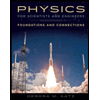An ideal gas expands at a constant pressure of 6.00 × 105 Pa from a volume of 1.00 m3 to a volume of 4.00 m and then is compressed to one-third that pressure and a volume of 2.50 m3 as shown in Figure P12.30 before returning to its initial state. How much work is done in taking a gas through one cycle of the process shown in the figure?
An ideal gas expands at a constant pressure of 6.00 × 105 Pa from a volume of 1.00 m3 to a volume of 4.00 m and then is compressed to one-third that pressure and a volume of 2.50 m3 as shown in Figure P12.30 before returning to its initial state. How much work is done in taking a gas through one cycle of the process shown in the figure?
Principles of Physics: A Calculus-Based Text
5th Edition
ISBN:9781133104261
Author:Raymond A. Serway, John W. Jewett
Publisher:Raymond A. Serway, John W. Jewett
Chapter17: Energy In Thermal Processes: The First Law Of Thermodynamics
Section: Chapter Questions
Problem 21P
Related questions
Question
An ideal gas expands at a constant pressure of 6.00 × 105 Pa from a volume of 1.00 m3 to a volume of 4.00 m and then is compressed to one-third that pressure and a volume of 2.50 m3 as shown in Figure P12.30 before returning to its initial state. How much work is done in taking a gas through one cycle of the process shown in the figure?
Expert Solution
This question has been solved!
Explore an expertly crafted, step-by-step solution for a thorough understanding of key concepts.
This is a popular solution!
Trending now
This is a popular solution!
Step by step
Solved in 2 steps with 1 images

Knowledge Booster
Learn more about
Need a deep-dive on the concept behind this application? Look no further. Learn more about this topic, physics and related others by exploring similar questions and additional content below.Recommended textbooks for you

Principles of Physics: A Calculus-Based Text
Physics
ISBN:
9781133104261
Author:
Raymond A. Serway, John W. Jewett
Publisher:
Cengage Learning

Physics for Scientists and Engineers: Foundations…
Physics
ISBN:
9781133939146
Author:
Katz, Debora M.
Publisher:
Cengage Learning

Principles of Physics: A Calculus-Based Text
Physics
ISBN:
9781133104261
Author:
Raymond A. Serway, John W. Jewett
Publisher:
Cengage Learning

Physics for Scientists and Engineers: Foundations…
Physics
ISBN:
9781133939146
Author:
Katz, Debora M.
Publisher:
Cengage Learning